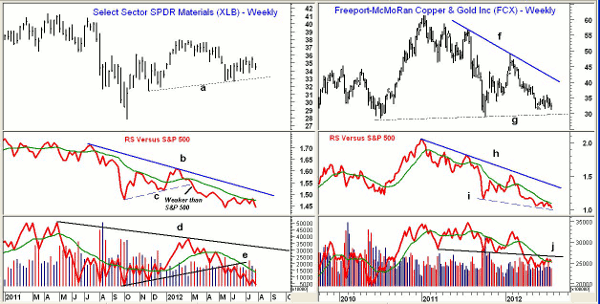There has been one major market sector that has been lagging the Spyder Trust (SPY) all year and MoneyShow’s Tom Aspray explains why he thinks it is still a sector that investors should avoid.
The stock market staged an impressive rally in response to comments from the European Central Bank’s Mario Draghi, but the negative divergences that formed last week have not been overcome. It would take several more equally strong days to reverse the technical deterioration.
So far this year, the Spyder Trust (SPY) is up over 8%, and despite the earnings shocks for the tech stocks this week, the Select Spyder SPDR Technology (XLK) is still up over 12%.
One economically sensitive sector that has continued to lag the market has been the Select Spyder SPDR Materials (XLB), which is up just 2.9% for the year. For those who believe that this sector has to turn around in order to signal an economic recovery, the technical action is not encouraging, as it suggests that buyers should be patient and stay out for now.
Chart Analysis: The Select Spyder SPDR Materials (XLB) had a rough 2011, down 12.8% for the year even though it did rebound in the last quarter. The rally in early 2012 peaked at $37.97.
- The weekly chart shows key support at $32.59 to $33 (line a). A break of this support will signal a drop back toward the October 2011 low of $27.77.
- The relative performance or RS analysis turned negative in March, when the uptrend (line c) was broken.
- The RS line has continued to make new lows, suggesting that prices will eventually follow. Long-term relative performance resistance at the downtrend (line b).
- The weekly on-balance volume (OBV) dropped below its WMA in March, then violated its uptrend (line e) in May. The OBV is already back to last October’s low.
- There is initial resistance now at $35, with further levels at $35.50 to $35.77.
The weekly chart of Freeport-McMoRan Copper & Gold (FCX) shows that after peaking in 2010 at $61.34, it has formed a series of lower highs (line f).
- FCX is now down almost 47% from the highs, and has short-term support now at $31.
- There is major support from 2010 and 2011 in the $28.35 to $28.85 area (line g).
- The RS analysis has already dropped below its 2011 lows (line i), and has been below its WMA since early in the year.
- The long-term downtrend in the relative performance (line h) is consistent with the stock’s weak performance.
- The weekly OBV dropped below important support (line j) in March, but has recently bounced back its WMA.
- There is short-term resistance now at $35 to $36, with stronger levels in the $38 to $40 area.
NEXT: Cliffs Natural Resources |pagebreak|
Cliffs Natural Resources (CLF) is a $5.5 billion mining and natural resource company that is part of the steel and iron industry group. It currently has a yield of 6.1%. The stock has been hit hard this week, and was down over 6% Thursday in reaction to its earnings miss.
- CLF is down over 38% for the year, breaking key support (line a) in May.
- This weekly chart shows a completed H&S top formation, with next major support from 2009 in the $32.50 area.
- CLF had a bear-market low of $11.84 in March 2009.
- The relative performance broke its almost two-year uptrend (line b) in August 2011, when CLF was trading at $77.
- The RS line has plunged to new lows this week, and is well below its WMA
- The volume was heavy this week, and the weekly OBV has been below its WMA since March.
- The major uptrend in the OBV (line c) was broken in April.
- There is strong resistance now in the $44 to $46 area.
What it Means: The market reaction has been mixed regarding the second-quarter GDP report this morning, but this is unlikely to give the materials sector much of a boost.
From a long-term perspective, I would not be surprised to see FCX bottom before the end of the year, but there are no strong signs yet that it has made a low.
CLF looks much more negative, and while some point to its attractive value, it seems more like a value trap. It is a good example of why those searching for yield should also examine all stocks from a technical perspective. Those who bought the stock at the end of March because of its then-attractive yield of 3.6% have seen the stock lose 45% of its value.
How to Profit: Clearly the technical outlook does not favor new positions in either XLB or these two materials stocks.
In yesterday’s Trading Lesson, I reviewed the current positions for the Charts in Play Portfolio. Until the stock-market outlook turns more positive, I would cancel any open stock or ETF orders. To view the current portfolio, click here.












